ABOUT BORNEO BIRDING

ASIA
BORNEO
| # Species: | 663 |
| # Excl Vagrants: | 581 |
| # Endemics: | 9 |
| # Near Endemics: | 66 |
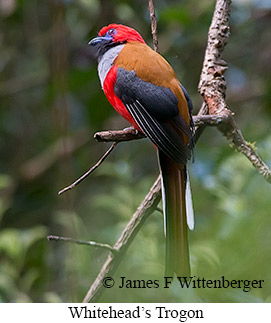 Borneo offers an astonishing diversity of all forms of life. The island straddles the equator and features unspoiled rainforest, higher elevation tropical evergreen forest, mangroves, and much more. Long gone are the headhunters that once prevailed on the island. The rainforest dates back some 130 million years and is home to exotic mammals such as Orangutan, Proboscis Monkey, Sumatran Rhinoceros and much more. The island is divided among 3 countries, Malayasia, Indonesia, and Brunei. The Malaysian states of Sabah and Sarawak along with the territory of Labuan make up about ¼ of the island. Brunei is a tiny country in the north, surrounded by Sarawak. The remainder of the Island consists of the 4 Indonesia states of East, West, Central, and South Kalimantan. The human population is concentrated along the coasts, and is largest in Kalimantan. The island was once covered by lowland rainforest, but much of it has been logged to support the plywood industry. Some of the remaining rainforest is in protected reserves but is still under threat as law enforcement is lax. Some experts predict that most of the lowland rainforest may be gone within 10 years without additional action. For birders the ongoing threats to Borneo rainforests add even more incentive to visit before further habitat degradation occurs.
Borneo offers an astonishing diversity of all forms of life. The island straddles the equator and features unspoiled rainforest, higher elevation tropical evergreen forest, mangroves, and much more. Long gone are the headhunters that once prevailed on the island. The rainforest dates back some 130 million years and is home to exotic mammals such as Orangutan, Proboscis Monkey, Sumatran Rhinoceros and much more. The island is divided among 3 countries, Malayasia, Indonesia, and Brunei. The Malaysian states of Sabah and Sarawak along with the territory of Labuan make up about ¼ of the island. Brunei is a tiny country in the north, surrounded by Sarawak. The remainder of the Island consists of the 4 Indonesia states of East, West, Central, and South Kalimantan. The human population is concentrated along the coasts, and is largest in Kalimantan. The island was once covered by lowland rainforest, but much of it has been logged to support the plywood industry. Some of the remaining rainforest is in protected reserves but is still under threat as law enforcement is lax. Some experts predict that most of the lowland rainforest may be gone within 10 years without additional action. For birders the ongoing threats to Borneo rainforests add even more incentive to visit before further habitat degradation occurs.
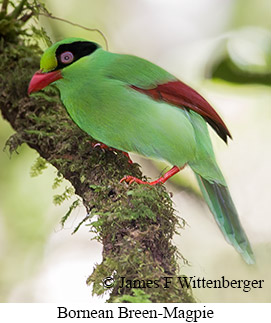 Most birding tours to Borneo concentrate on Sabah, and for good reason. Sabah offers better infrastructure with better accommodations along with a larger percentage of protected forests than other parts of Borneo. The northern part of Sabah features montane forests on the slopes of Mount Kinabalu. The national park protecting this area is home to over 20 endemic birds, including higher elevation specialties such as Bornean Stubtail, Friendly Bush Warbler, Sunda Bush Warbler, and Mountain Black-eye. En route to the national park is the heavily touristed Poring Hotsprings, where it's possible to find a number of middle elevation birds including the prized Rufous-collared Kingfisher, and Rafflesia Forest Reserve where it's possible to find specialties such as Mountain Barbet, Bornean Barbet, Bornean Bulbul, Fruit-hunter, and Bornean Leafbird.
Most birding tours to Borneo concentrate on Sabah, and for good reason. Sabah offers better infrastructure with better accommodations along with a larger percentage of protected forests than other parts of Borneo. The northern part of Sabah features montane forests on the slopes of Mount Kinabalu. The national park protecting this area is home to over 20 endemic birds, including higher elevation specialties such as Bornean Stubtail, Friendly Bush Warbler, Sunda Bush Warbler, and Mountain Black-eye. En route to the national park is the heavily touristed Poring Hotsprings, where it's possible to find a number of middle elevation birds including the prized Rufous-collared Kingfisher, and Rafflesia Forest Reserve where it's possible to find specialties such as Mountain Barbet, Bornean Barbet, Bornean Bulbul, Fruit-hunter, and Bornean Leafbird.
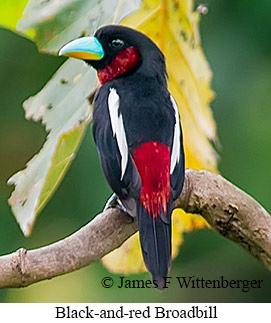 On the east coast of Sabah are several notable birding locales. Sites typically visited by tour groups are Sepilok and the Kinabatangan River. The Rainforest Discovery Center at Sepilok, some 24km from the town of Sandankan, features lowland rainforest and a canopy walkway that allows closer viewing of mid-story and canopy birds. A 5km trail provides access into the mangrove forest at the nearby Sepilok Orang Utan Sanctuary.
On the east coast of Sabah are several notable birding locales. Sites typically visited by tour groups are Sepilok and the Kinabatangan River. The Rainforest Discovery Center at Sepilok, some 24km from the town of Sandankan, features lowland rainforest and a canopy walkway that allows closer viewing of mid-story and canopy birds. A 5km trail provides access into the mangrove forest at the nearby Sepilok Orang Utan Sanctuary.
South of Sepilok is the Kinabatangan River, the second longest river in Malaysia. Habitat along the upper reaches of the river have been seriously degraded by excessive logging and clearing of land for Oil Palm plantations. Nearer the coast lowland rainforest and mangrove swamps are still fairly intact. A boat trip along the Kinabatangan River is highly worthwhile. It's possible to see all 8 species of hornbills and such rarities as Storm's Stork and Lesser Adjutant. Mammal watching along the river is also excellent. Possibilities include several species of primates including Silvered Langur, Proboscis Monkey, and Orang Utan.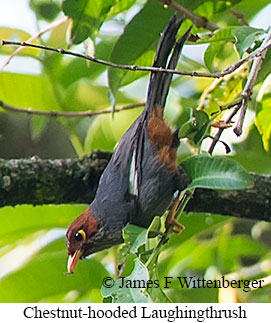 The estuary near the mouth of the river is home to Saltwater Crocodiles. Trails at the nearby Sukau Rainforest Lodge provide access to the forest interior where it's possible to see birds such as Black-crowned Pitta, Hooded Pitta, Bar-bellied Cuckooshrike, and 3 species of trogons. It's also one of the best places to look for the rare and secretive Bornean Ground-Cuckoo. Near Sukau are the Gomontong Caves, where at dusk some 2 million bats egress the caves while a similar number of swifts return to the caves to roost.
The estuary near the mouth of the river is home to Saltwater Crocodiles. Trails at the nearby Sukau Rainforest Lodge provide access to the forest interior where it's possible to see birds such as Black-crowned Pitta, Hooded Pitta, Bar-bellied Cuckooshrike, and 3 species of trogons. It's also one of the best places to look for the rare and secretive Bornean Ground-Cuckoo. Near Sukau are the Gomontong Caves, where at dusk some 2 million bats egress the caves while a similar number of swifts return to the caves to roost.
Farther south is the Tabin Wildlife Center, less often visited by birding groups because access to primary forest is difficult. The accessible areas are mainly secondary forest, which allows good viewing of more open canopy species such as raptors and hornbills. Of greater note is mammal watching at Tabin, which is the best place to see the endangered Sumatran Rhinoceros and is also a good place to see Batang and Borneo Pygmy Elephant.
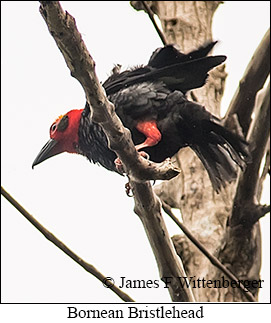 In southern Sabah is the magical Danum Valley, once home to headhunters but now safe and the most protected part of Borneo. The Danum Valley Conservation area was never affected by human habitation and features essentially unspoiled lowland forest. The field center there is a scientific research establishment that can be visited but does not provide accommodation to non-Malaysian visitors. Instead, visitors must stay at the extremely expensive ($400-500/night/person) Borneo Rainforest Lodge. The rainforest around the lodge make a visit well worthwhile. It's considered by many to be the single most extraordinary rainforest experience in the world. Birding can be difficult in the primary forest, but attractions are many. An extensive network of trails and a canopy walkway offer opportunities to see specialties such as Great Argus, Giant Pitta, Bornean Banded-Pitta, Black-headed Pitta, Bornean Bristlehead, Bornean Wren-Babbler, and Bornean Spiderhunter. Mammals regularly seen there include Mullers Bornean Gibbon, Red Leaf Monkey, and Orang Utan. Night drives can turn up Slow Loris, Leopard Cat, and Civet.
In southern Sabah is the magical Danum Valley, once home to headhunters but now safe and the most protected part of Borneo. The Danum Valley Conservation area was never affected by human habitation and features essentially unspoiled lowland forest. The field center there is a scientific research establishment that can be visited but does not provide accommodation to non-Malaysian visitors. Instead, visitors must stay at the extremely expensive ($400-500/night/person) Borneo Rainforest Lodge. The rainforest around the lodge make a visit well worthwhile. It's considered by many to be the single most extraordinary rainforest experience in the world. Birding can be difficult in the primary forest, but attractions are many. An extensive network of trails and a canopy walkway offer opportunities to see specialties such as Great Argus, Giant Pitta, Bornean Banded-Pitta, Black-headed Pitta, Bornean Bristlehead, Bornean Wren-Babbler, and Bornean Spiderhunter. Mammals regularly seen there include Mullers Bornean Gibbon, Red Leaf Monkey, and Orang Utan. Night drives can turn up Slow Loris, Leopard Cat, and Civet.
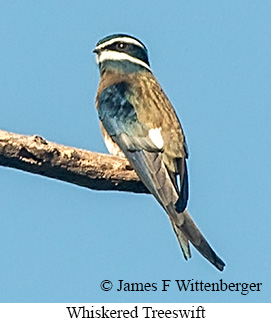 Other parts of Borneo are less visited by birders. Sarawak is a largely neglected birding destination, partly because Sabah is so wonderful and partly because suitable accommodations are more limited in Sarawak. Some endemics and poorly known species are best seen or only possible in Sarawak. Examples are Pygmy White-eye, best seen at places such as the Borneo Highlands Resort in Sarawak, the poorly known Hoses Partridge, currently considered a subspecies of Long-billed Partridge but possibly a separate species, Fairy Pitta, Black Oriole, Long-billed Blue Flycatcher, and Hook-billed Bulbul.
Other parts of Borneo are less visited by birders. Sarawak is a largely neglected birding destination, partly because Sabah is so wonderful and partly because suitable accommodations are more limited in Sarawak. Some endemics and poorly known species are best seen or only possible in Sarawak. Examples are Pygmy White-eye, best seen at places such as the Borneo Highlands Resort in Sarawak, the poorly known Hoses Partridge, currently considered a subspecies of Long-billed Partridge but possibly a separate species, Fairy Pitta, Black Oriole, Long-billed Blue Flycatcher, and Hook-billed Bulbul.
Similarly, few birders visit Kalimantan, the Indonesian side of Borneo. Again, suitable accommodations are more limited. In addition, distances are greater so it's more difficult to cover this part of Borneo. Many of the same species can be seen in Sabah, but some are different. Examples include Bulwer's Pheasant, Bornean Peacock-Pheasant, Dusky Moorhen, Silvery Wood-Pigeon, Rajah Scops-Owl, Dulit Frogmouth, Blue-wattled Bulbul, Lemon-bellied White-eye, and Scarlet-headed Flowerpecker. Many of these can be seen on other islands of Indonesia as well.
OTHER COUNTRIES
IN ASIA
BIRDING LOCALES
§ Excludes Taiwan
§§ Includes Wallacea but excludes Kalimantan (Borneo) and West Papua New Guinea & nearby islands
§§§ Excludes Sarawak and Sabah on Borneo





